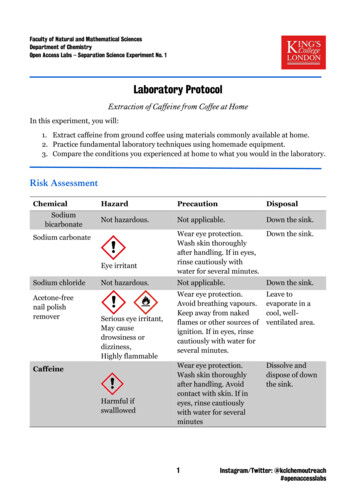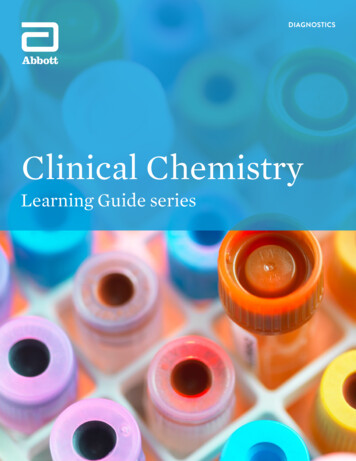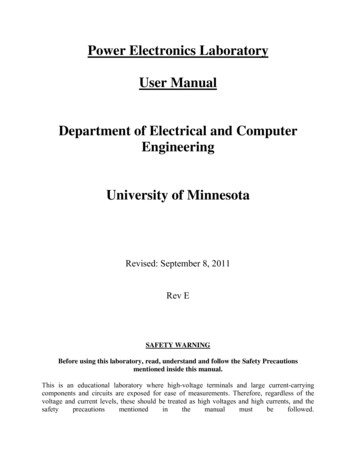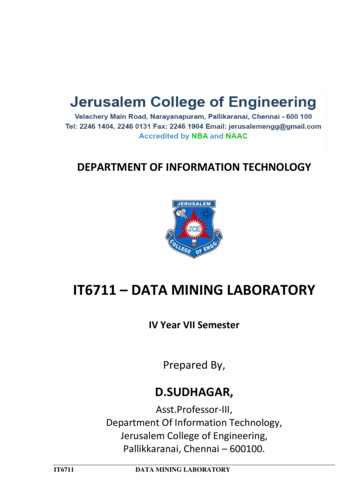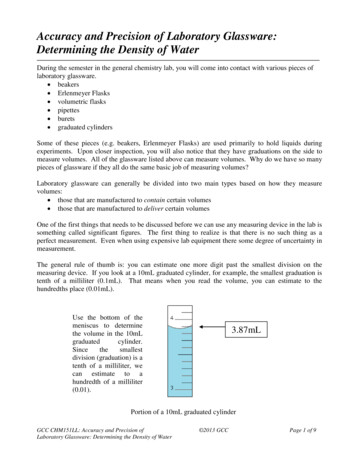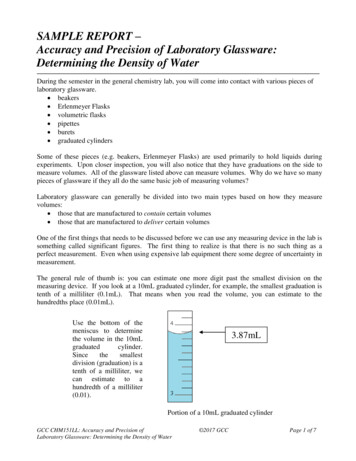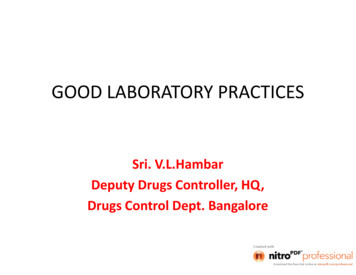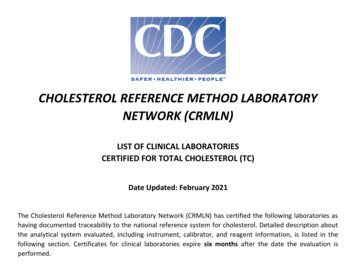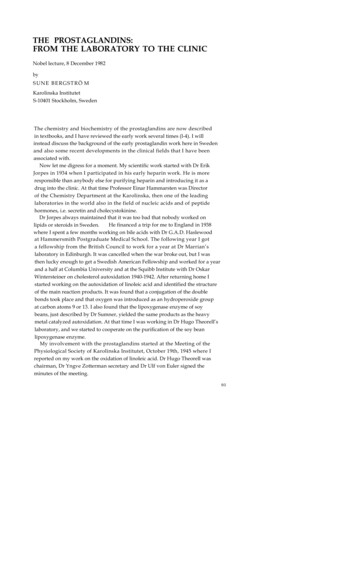
Transcription
THE PROSTAGLANDINS:FROM THE LABORATORY TO THE CLINICNobel lecture, 8 December 1982bySUNE BERGSTRÖ MKarolinska InstitutetS-10401 Stockholm, SwedenThe chemistry and biochemistry of the prostaglandins are now describedin textbooks, and I have reviewed the early work several times (l-4). I willinstead discuss the background of the early prostaglandin work here in Swedenand also some recent developments in the clinical fields that I have beenassociated with.Now let me digress for a moment. My scientific work started with Dr ErikJorpes in 1934 when I participated in his early heparin work. He is moreresponsible than anybody else for purifying heparin and introducing it as adrug into the clinic. At that time Professor Einar Hammarsten was Directorof the Chemistry Department at the Karolinska, then one of the leadinglaboratories in the world also in the field of nucleic acids and of peptidehormones, i.e. secretin and cholecystokinine.Dr Jorpes always maintained that it was too bad that nobody worked onHe financed a trip for me to England in 1938lipids or steroids in Sweden.where I spent a few months working on bile acids with Dr G.A.D. Haslewoodat Hammersmith Postgraduate Medical School. The following year I gota fellowship from the British Council to work for a year at Dr Marrian’slaboratory in Edinburgh. It was cancelled when the war broke out, but I wasthen lucky enough to get a Swedish American Fellowship and worked for a yearand a half at Columbia University and at the Squibb Institute with Dr OskarWintersteiner on cholesterol autoxidation 1940-1942. After returning home Istarted working on the autoxidation of linoleic acid and identified the structureof the main reaction products. It was found that a conjugation of the doublebonds took place and that oxygen was introduced as an hydroperoxide groupat carbon atoms 9 or 13. I also found that the lipoxygenase enzyme of soybeans, just described by Dr Sumner, yielded the same products as the heavymetal catalyzed autoxidation. At that time I was working in Dr Hugo Theorell’slaboratory, and we started to cooperate on the purification of the soy beanlipoxygenase enzyme.My involvement with the prostaglandins started at the Meeting of thePhysiological Society of Karolinska Institutet, October 19th, 1945 where Ireported on my work on the oxidation of linoleic acid. Dr Hugo Theorell waschairman, Dr Yngve Zotterman secretary and Dr Ulf von Euler signed theminutes of the meeting.93
94Physiology or Medicine 1982After this meeting von Euler asked me if I might be interested to study thesmall amount of his lipid extracts of sheep vesicular glands that he had storedsince before the war. I agreed, and we began a most stimulating and pleasantcooperation.The first observation that there was some biologically active compounds inhuman semen had been done in the Department of Obstetrics and Gynecologyat Columbia University in New York. In 1930 Kurzrok and Lieb with thetechnical cooperation of Dr Sara Ratner (5) reported that when they weredoing artificial inseminations in women, they sometimes got violent contractions, sometimes relaxation, of the uterus.An interesting coincidence is that I met Dr Kurzrok and worked at the samelaboratory at Columbia University as Dr Sara Ratner for a year but never heardanything about prostaglandin.In 1933 the British pharmacologist Goldblat (6, 7) had reported that humansemen contained a factor that reduced blood pressure and stimulated smoothmuscle.At about the same time Dr von Euler was making a thorough study of theoccurrence of compound P in various organs, the peptide he had discovered afew years earlier. In semen and in extracts of “prostate” or vesicular glands ofmonkeys, sheep and goats there was a strong blood pressure decreasing factorthat also stimulated smooth muscles. He showed that the factor was differentfrom P, that it was lipid soluble and he gave it the name prostaglandin. DrTheorell had shown that the activity behaved as an acid in his electrophoresisappartus (8-10).In the early work the rabbit intestinal strip test was used to follow theactivity. We used mainly countercurrent extractions to purify von Euler’s crudeextract.I had just brought home one of Dr Lyman Craig’s stainless steel countercurrent extraction machines that proved ideal for working with these smallamounts. We managed to purify the crude extract about 500 times. The mostactive fractions consisted of unsaturated hydroxy acids that were free of nitrogen (11).The work was interrupted for a few years due to my appointment to the chairof physiological chemistry at the University of Lund in 1948.A practically empty institution had to be rebuilt, reequipped and staffed,but it was a very fortunate time (1948) for the biomedical sciences in Sweden.The large buildup of resources for basic biomedical research at the SwedishUniversities, initiated by the former Prime Minister Tage Erlander, had juststarted. The Swedish Medical Research Council had also just been started. Anadditional advantage during the following decade was that the National Institutes of Health (NIH) in the U.S.A. started their unique international programme of support of biomedical research.We were fortunate to receive quite sizeable grants for our work in the field ofsteroid and bile acid metabolism from NIH for a number of years.A group of able graduate students could then be trained in these fieldsBengt Borgström, Jan Sjövall, Sven Lindstedt, Henry Danielsson, Bengt Sa-
The Prostaglandins: from the Laboratory to the Clinic95mulesson and Rolf Blomstrand. They have all more or less directly contributedto the early prostaglandin development that was started up again in the fifties.Collection of sheep glands was organized in Sweden and Norway. Usingcounter current fractionations and partition chromatography two crystallingcompounds prostaglandin E 1 and F 1a (12-14) were isolated in small amountsin 1957.The correct empirical formulas could be determined in cooperation withWolfgang Kristen who had developed an ultramicro carbon-hydrogen determination in Dr Einar Stenhagen’s laboratory in Uppsala. Together with themolecular weight, determined by Dr Ragnar Ryhage in his mass spectrometer,the formulas were found to be C20 H 34 O 5 and C 20 H 36 O 5 , respectively.Collection of sheep glands was then expanded in Sweden, Norway, Iceland,Greenland and also in the U.S.A. through the Horniel Institute. These activitieswere generously supported by the Upjohn Co., U.S.A.In 1958-1959 the whole research group moved from Lund to the Department of Chemistry at the Karolinska Institute in Stockholm. What reallyplayed a decisive role in the prostaglandin work was the mass spectrometerdevelopment that Dr Ragnar Ryhage was doing there. He had built the first
Physiology or Medicine I982BIOSYNTHESIS OF PROSTAGLANDINSfunctioning combination instrument of a gas chromatograph and a mass spectrometer. The structure of PGE 1 and F 1α was then deduced largely from massspectrometric identification of the products formed by oxidative degradation ofthese prostaglandins and the compounds formed from PGEl by treatment witha weak acid or base indicated in Fig. 1. The structure was then confirmed andthe stereochemistry determined by Dr Sixten Abrahamsson in Gothenburg ona derivative ofIt took him about one year to do this using the technologyof those days. Today it would take less than three weeks. The absoluteconfiguration was finally settled (25,26).By 1962 the six prostaglandins as listed in Fig. 2 had been isolated and theirstructures determined (15-24). It had also been found that these prostaglandins occur in many other tissues outside the male reproductive organs.These 20-carbon prostaglandins have cis-double bonds located as in certainessential fatty acids, when counting from the carboxyl. This made us suspectthat these naturally occurring acids might be precursors.I then telephoned Dr David van Dorp at Unilevers Research Laboratories inHolland where these acids had been synthesized and isotopically labelledearlier. When I asked him if we could get some isotopically labelled C20 acids, itturned out that he was also planning to start investigating if they were precursors, and he had just prepared isotopically labelled dihomogamma-linoleicacid for this purpose. He was most generous and sent us samples of the labelledacid. We started simultaneously incubating the labelled acids with homogenates of sheep glands and could inform each other after two days that indeedlabelled prostaglandin E l and F 1a were produced in good yield. We published
The Prostaglandins: From the Laboratory to the Clinic97our findings simultaneously in 1964. This work was then followed up with thelabelled tetraenoic arachidonic acid and the pentaenoic acid shown in Fig. 2which yielded prostaglandins of the 2 and 3 series, respectively (27-30). Thisdiscovery was also made independently at the Upjohn Co. using glands frombulls.As the yields could be up to 70% these enzymatic methods were of greatpractical importance for getting material for further biochemical, physiologicaland pharmacological work.We prepared several grammes of various prostaglandins whereas Unilevermade considerably more, and the Upjohn Co. must have prepared hundredsof grammes.In spite of the biosynthetic method the supply situation became criticalaround 1970 when prostaglandins were needed for clinical work before largescale total syntheses had been developed. An unexpected discovery was thenmade by Weinheimer and Spraggins (31) who had been studying the biochemistry of marine organisms in the Mexican Gulf. They found that up to one andone half percent of the dry weight of a Gorgonia coral consisted of 15 epiprostaglandin A 2 and related compounds. For several years the Upjohn Co. isolatedthese prostaglandins from corals which they transformed into the prostaglandins supplied for clinical trials. But from about 1973 the supplies have beenprepared by total synthesis.When the structure of the prostaglandins was published, many projectshad been started on their total synthesis.Dr E. J. Corey, who had collaborated with us in studies of the biosynthesis ofbile acids with his stereospecifically labelled cholesterol, was the first to succeed. In a series of classical papers in 1968-69 (32-37) he described severalelegant methods that still form the basis for most synthetic work in theprostaglandin field.By that time many pharmaceutical industries had become interested in thefield and large synthetic programmes to synthesize prostaglandin analogueswere started. These synthetic efforts were in part guided by the knowledge ofthe metabolism of prostaglandins accumulated in Stockholm. More than 5000prostaglandin analogues have now been prepared and tested in one way oranother.When the biosynthesis from the precursor acids was done with homogenatesfrom lungs, it had been found that the prostaglandins formed were extensivelyfurther metabolized to inactive compounds (38-41) as indicated in Fig. 3, i.e.by saturation of the double bond between carbon 13 and 14 and dehydrogenation at C 15. These reactions are so effectiv e in vivo that these prostaglandins areusually almost completely inactivated during one passage through the lungs. Inlater work in vivo it was found that these inactive compounds are further betaand gammaoxidized before excretion. A possible way to block the first reactionsis to replace the C l5 hydrogen with a methyl group. The 15-methyl prostaglandins that were prepared by Bundy et al. at the Upjohn Co. (42) turned outto be very useful for clinical work and 15-methyl F 2α is now registered as a drug.Some of the different analogues that have been studied in the clinic are listed
Physiology or Medicine 1982VFigure 3. Main metabolic pathway of PGF2, and its inhibition by the methyl group at C-15.in Fig. 4. All are prepared by the Upjohn Co. unless indicated. These efforts toget compounds with longer lasting or more specific actions are continuing.In the early sixties we had some difficulty trying to convince our colleagues tostudy the properties of the prostaglandins in their various pharmacologicaland physiological systems. This changed expecially after early studies done incooperation with Drs Dan Steinberg, Martha Vaughan and Jack Orloff at theNational Institutes of Health (43-47). They were working with rat adiposetissue that releases glycerol and fatty acids due to increased lipolysis whenstimulated with epinephrine, norepinephrine, glucagon or ACTH. It was foundthat PGE l and PGE 2 strongly inhibited the effects of all these compounds.PGE 1 and PGE 2 were also found to counteract both the lipolysis and the blood
The Prostaglandins: from the Laboratory to the Clinic99Figure 4. Some prostaglandin analogues that have been studied in clinical trials.pressure effect caused by epinephrin e in vivo. It was later found that theseeffects were mediated by a decrease in the level of cyclic AMP in the fat cells. Inthis case the level was decreased. In most other cell types the E prostaglandinsraise the level of cAMP. In some cases the F prostaglandins have been shown toinfluence the level of cyclic GMP. I am not going further into this field, butthese findings explain why various prostaglandins can influence the metabolism of so many different cell types. A comprehensive summary of the earlystudies of the biological effects of the prostaglandin was published in 1968 (48).It turned out that there were not only large differences between the effects ofdifferent prostaglandins and their analogues but also between different animalspecies. Obviously one had to turn to clinical studies in order to explore thephysiological role and therapeutic potential of these compounds.The first study on the cardiovascular effects of the pure prostaglandins inhumans was done at the Karolinska (49, 50). In humans PGE1 caused a fall inblood pressure and an increase in heart rate. My colleagues Drs Lars A.Carlson, Bengt Per
the formulas were found to be C 20 H 34 O 5 and C 20 H 36 O 5, respectively. Collection of sheep glands was then expanded in Sweden, Norway, Iceland, Greenland and also in the U.S.A. through the Horniel Institute. These activities were generously supported by the Upjohn Co., U.S.A. In 1958-1959 the whole research group moved from Lund to the Depart-ment of Chemistry at the Karolinska Institute .
